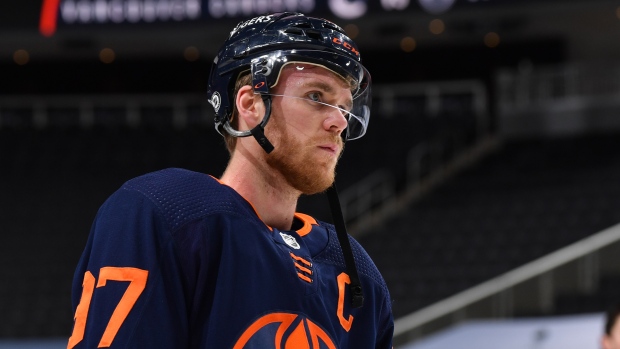Feb 22, 2022
The McDavid penalty debate continues
The Edmonton Oilers superstar can seemingly draw penalties at will, except for when the whistles have been swallowed, Travis Yost writes.
By Travis Yost

A couple of months ago, Edmonton Oilers fans were up in arms about the rate at which Connor McDavid was drawing penalties. It’s been a hot topic since he’s entered in the league: How does the most game-breaking talent in hockey draw so few penalties relative to what’s observable on the ice, and how can the NHL justify it?
The debate has never abated, in large part because the NHL has never sought resolution for the issue. Right or wrong, game management and the prioritization of game flow run counter to calling the NHL rulebook. If you haven’t read through the NHL rulebook recently, I encourage you to do so. It’s so far removed from the reality of where the sport is right now that it almost feels like it’s intended for a different league.
So, why talk about McDavid and penalties now? Since the ugliness of a few months ago, McDavid has been drawing penalties at a blistering pace.
He has drawn seven penalties in the past six games, which is more than Alexander Ovechkin has drawn all season, and twice as many as Steven Stamkos has drawn this year. Ovechkin and Stamkos are fundamentally different players, but you get an idea of how significant the gap is.
This isn’t the first time we have seen a rip to the upside for McDavid and drawn penalties. In fact, it’s been a story of his entire career. The groans over officiating and game management have increased year over year since McDavid entered the league, and he’s become the test case for what the NHL is getting wrong.
There are many things, including randomness, you could attribute to the below graph. But I don’t think it’s unreasonable to wonder if the NHL is sensitive to public chatter about McDavid (and its officiating strategy, more broadly). Because every time McDavid goes into a penalty-drawing lull and heads towards league averages, the trend whipsaws. Not most of the time, every single time.
It’s remarkable to see visualized:

When McDavid is drawing penalties, he’s usually being hooked, held, or interfered with – the exact type of infractions you would expect from defensive players caught out of position, or futile attempts to force McDavid out of his path.
What’s more interesting is the relationship between the rate at which McDavid draws penalties and the rate at which he draws penalties specific to those three categories. One of the prominent arguments from Oilers fans is that hooks, holds, and interfering plays can be found on every McDavid shift, and it’s only a matter of whether the officials make the call.
Let’s look at the same trended graph, but controlling for just these three penalties:

In the early parts of McDavid’s career, he was drawing all sorts of penalties. Over the past three seasons, the McDavid trendline only moves contingent on how hooks, holds, and interfering plays are called.
It’s important to frame why this is an issue. In the NHL, the aggregation of these penalties is worth about 29 per cent of total penalties called; that number is a few ticks higher when you subset to just the forward group. But for McDavid, it’s more than 60 per cent of penalties drawn.
Again, we would expect McDavid to deviate here in some capacity – freakish athletes like McDavid tend to be magnets for this sort of infraction. But said differently, McDavid and the Oilers (by extension) are reliant on this type of infraction being called, assuming the infraction in and of itself occurs. If these aren’t called, McDavid just doesn’t draw penalties.
To be sure, McDavid draws a significant number of penalties. Excluding majors, he’s drawn (comfortably) the most penalties since entering the league:

A large percentage of that advantage stems from hooking, holding, and interfering calls. Whenever McDavid is relatively struggling to draw penalties, it coincides with a lull in those exact type of plays being called.
That, at its simplest form, is the grievance of the Oilers fan base and organization. McDavid can seemingly draw penalties at will, except when he can’t. And when he can’t, there’s ample video evidence he is being hooked and held.
But you can’t call penalties when the whistle is swallowed.
Data via Natural Stat Trick, Evolving Hockey, NHL.com, Hockey Reference

